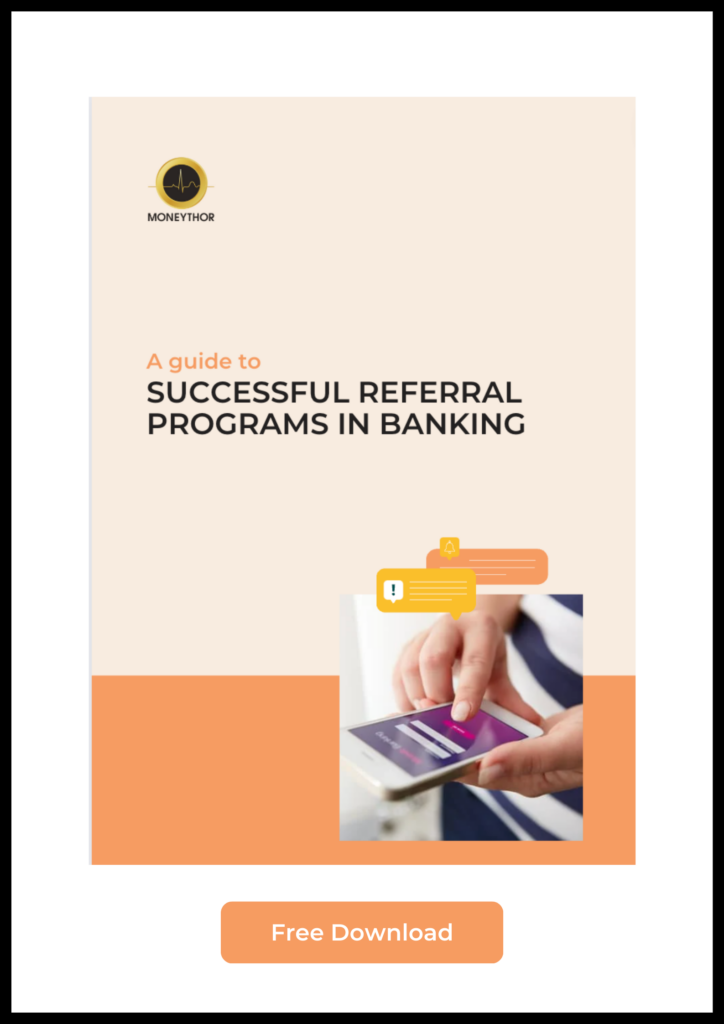The value of incentivised referrals
With many financial institutions vying for market share, the pressure to distinguish oneself from competition is high. Simply offering basic banking services is no longer enough. Both traditional and digital banks must constantly adapt and innovate in order to attract new customers. Innovative strategies are the key to standing out in this crowded market.
Acquiring new customers is not just a strategic choice for banks; it’s essential for revenue growth. As banks expand their customer base, they tap into a wider pool of depositors, borrowers, and investors, ultimately leading to increased income streams. Statistics consistently underline the direct correlation between customer acquisition and financial success. Research reveals that banks with successful customer acquisition strategies experience higher profit margins and greater long-term financial stability. In an era where the financial industry is continually evolving, the ability to attract and retain new customers is a linchpin for sustained revenue growth, making it imperative for banks to prioritise effective acquisition strategies in their operational models.
Banks are exploring new avenues, such as incentivised referrals and Member-Get-Member (MGM) programs, to gain a competitive edge and increase the success of their acquisition strategies. Incentivised referrals involve rewarding existing customers (Existing To Bank or ETB) for referring new ones (New To Bank or NTB). This guide explores why such referrals can be a crucial tool for customer acquisition in banks when implemented correctly, and provides actionable insights on how to implement a successful referral program.
What are incentivised referrals?
Incentivised referrals are when existing customers are motivated to recommend a bank’s products or services to their friends, family, or acquaintances. This process capitalises on the trust and credibility established within personal networks, as referrals from known sources are often more compelling to potential customers.
The role of incentivised referrals is to leverage this trust to amplify a bank’s reach, attract new customers, and foster growth. In the banking industry, referral incentives can take various forms, such as cash rewards, interest rate bonuses, waived fees, vouchers, lucky draw chances or exclusive account benefits for both the referrer and referee. These incentives serve as tangible rewards for loyal customers, encouraging them to actively participate in expanding the bank’s customer base, while simultaneously providing attractive perks to new customers, thereby creating a win-win scenario for all parties involved.
Incentivised referrals are highly effective due to the intrinsic trust and credibility associated with referrals from friends and family. When individuals receive recommendations from their trusted social circles, it triggers a sense of reliability and assurance, making them more inclined to explore the recommended bank’s offerings.
The psychological principle of social proof, wherein people tend to follow the actions of those they trust, comes into play here. Additionally, the introduction of incentives adds an extra layer of motivation, making the referrer more likely to advocate for the bank, while the referee, enticed by the promised rewards, is more likely to take action. This synergy of trust, social influence, and rewards makes incentivised referrals a powerful strategy in many industries including banking, fostering not only customer acquisition but also brand loyalty and long-term relationship banking, fostering not only customer acquisition but also brand loyalty and long-term relationships.
What are the benefits of incentivised referrals?

Cost-efficiency
In the realm of customer acquisition, incentivised referrals are inherently cost-effective compared to traditional marketing channels. Unlike expensive advertising campaigns or extensive outreach efforts, referral programs leverage the existing customer base, effectively transforming loyal clients into brand advocates. This not only reduces the need for substantial advertising budgets but also results in a more efficient allocation of resources. With incentivised referrals, banks can channel their investments more directly towards rewarding their existing customers for successful referrals, rather than pouring vast sums into broad marketing initiatives.

Improved customer loyalty
Implementing incentivised referral programs in banks not only helps attract new customers but also enhances the loyalty of the existing customer base. When customers actively participate in referring friends and family, they become more invested in the bank’s success and reputation. This increased sense of involvement tends to translate into greater loyalty, as these referrers are more likely to stay engaged and satisfied with the bank’s services. Moreover, their personal stake in the bank’s growth encourages them to explore other products and services, thus opening doors for cross-selling and upselling opportunities. The bank can capitalize on this trust and loyalty to introduce additional offerings, which are more likely to be well-received, further boosting revenue and solidifying long-term customer relationships.
How to implement a successful incentivised referral program?
Referral programs are not new. Most banks have trialled some version of a referral or Member-Get-Member program with varying degrees of success. So why should banks focus on referrals now? And what should be done differently to ensure they are successful?
Leverage the referrer / referee relationship
Leveraging the referrer/referee relationship is crucial to implement a successful referral program because it taps into the inherent trust and credibility within personal networks. Close friends and family recommendations carry significant weight, making the referral process more authentic and compelling. The Moneythor solution is capable of managing this relationship across both accounts providing rewards to both parties as they complete various tasks and actions.
Be smart with incentives
Being smart with incentives is vital to motivate both referrers and referees. By offering rewards that are attractive and valuable to participants, the program becomes more enticing and increases the likelihood of active engagement and successful referrals. Additionally applying incentives in interesting ways and splitting them across activities can enable banks to spread out the incentives over time.
Do not stop at onboarding
A recurring issue of legacy referral programs is that they used to deliver the referral reward at the time of a successful onboarding and stop there, leading to numerous new customers only completing the process to earn the reward, but disappearing after this initial step. Creating long-running activities post-onboarding for new customers to complete for both they and their referrers to receive the full incentives is a crucial method of modern referral programs. It can further be reinforced by nudging the referrers to nudge their referees into completing those additional steps to maximise their mutual benefits.
Use challenges and gamification techniques
Using challenges and gamification techniques adds an element of fun, driving increased participation and enthusiasm. Creating challenges or incorporating gamified elements into the referral process makes it more enjoyable for participants, encouraging sustained engagement and fostering a sense of competition and achievement throughout the program.
Download Referral Programs Guide
"*" indicates required fields


